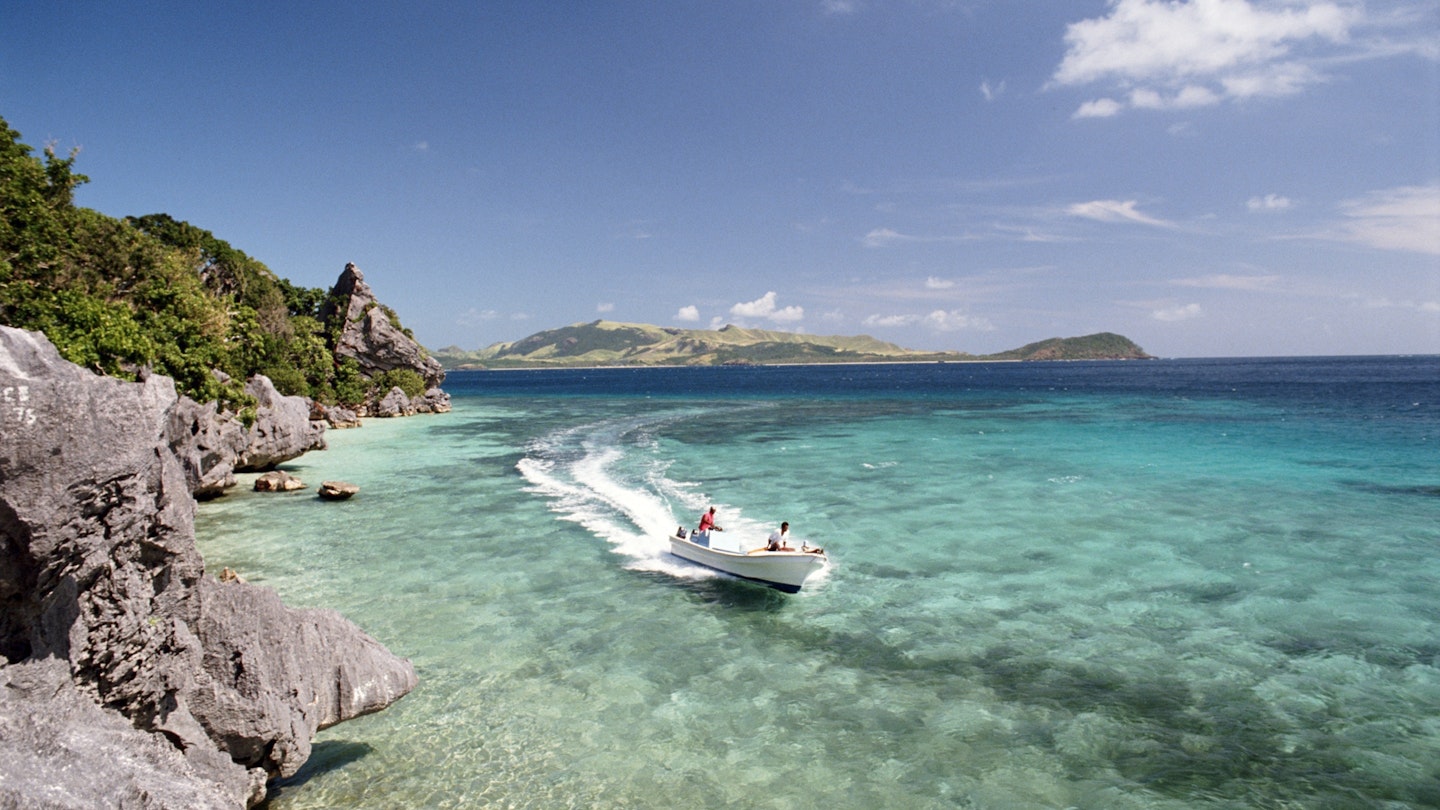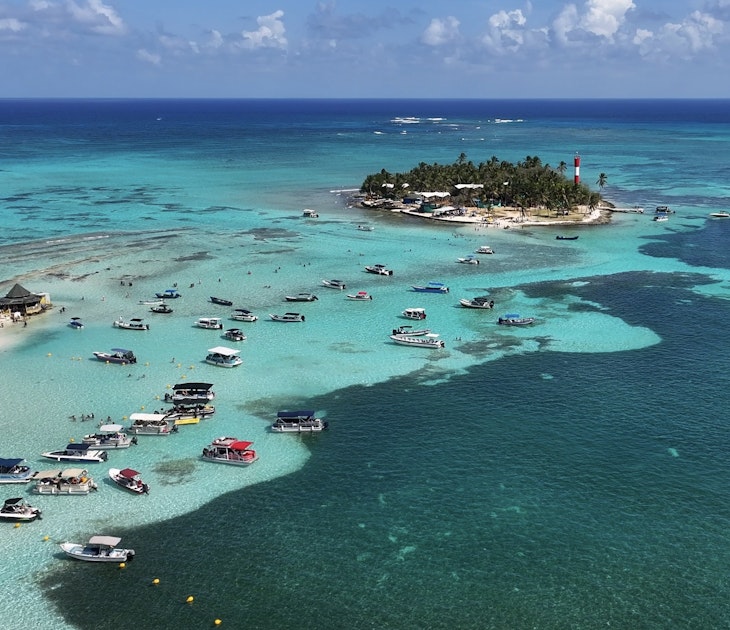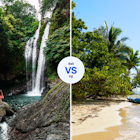

Find the best time to relax on one of Fiji’s dazzling islands. Getty Images
White sand beaches, swaying palm fronds, colorful coral reefs: for many, the allure of Fiji is in its landscapes. Yet this South Pacific archipelago offers just as many incredible local experiences that complement its natural assets.
The best weather in Fiji coincides with higher prices and bigger crowds, but there’s never a bad time to visit – not even during cyclone season (I'll explain why).
- placement: fullWidth
- path: articles/in-content-top
- possible size: [970, 250], [970, 90], [728, 90], [300, 250], [320, 50], [1, 1],
- targeting:
{ "url": "best-time-to-visit-fiji", "destination": "Fiji", "continent": "Australia-&-Pacific", "country": "Fiji" }
Whether you want to lounge on a beach, sail between islands or snorkel with manta rays, here’s the best time to head to Fiji.

June to September is the high season in Fiji – with idyllic weather
Fiji has two seasons: summer (the wet season) and winter (the dry season). The latter (generally June to September) is the peak tourist season in Fiji with temperatures hovering between 20–30ºC (68–86ºF). Expect an uptick in accommodation prices. The large resorts on Denarau Island are usually filled with families from Australia and New Zealand, who come during their winter school holidays.
The words “high season” might conjure images of crowds jostling for a spot in the sand, but outside of Denarau, resorts are spread out amongst the islands, making it possible to find a slice of serenity even at this busy time of year.
This is also the best time to enjoy Fiji’s ocean adventures. Surfers saddled with board bags and spare leashes come to catch waves at iconic surf spots like Cloudbreak at Tavarua Island, home to the World Surf League Championships. Even if you’re not a surfer, it’s worth catching the 20-minute boat ride out to watch the pros try to make it through near-perfect barrels.
- placement: fullWidth
- path: articles/in-content-middle
- possible size: [970, 250], [970, 90], [728, 90], [300, 250], [320, 50], [1, 1],
- targeting:
{ "url": "best-time-to-visit-fiji", "destination": "Fiji", "continent": "Australia-&-Pacific", "country": "Fiji" }
Peer out on the horizon during these months and you’ll likely notice the silhouettes of sails out over the water. Sailors from throughout the South Pacific blow into Fiji to explore the islands by boat and participate in Fiji Regatta Week during September. It’s a great time to sign up for a day’s sailing or try your hand on your resort’s Hobie catamaran. For a glimpse at Fiji’s long seafaring history, pay a visit to the Fiji Museum and admire a replica drua, a traditional sailing canoe. A working 72ft (22m) traditional vessel, the Uto Ni Yalo often sails around the islands during this time as well.
Under the sea’s surface, there’s plenty going on during this time too. The best time to scuba dive and snorkel with manta rays is from May to October, as they hang around Fiji’s Yasawa Islands and the Great Astrolabe Reef off Kadavu. A lack of rainfall around the islands of Vanua Levu and Taveuni creates great visibility during this time for scuba divers keen to explore thriving reefs of soft and hard corals.

Visit Fiji in May or October for fewer crowds but plenty of sun
May and October are considered Fiji’s shoulder months, offering that sweet spot of fewer fellow tourists and pleasant weather. In May, the start of the dry season, temperatures climb towards the high 20°Cs (high 60ºFs). By the end of October, Fiji’s temperatures consistently warm up to the low 30°Cs (low 80ºFs) with relatively low humidity.
October is also one of Fiji’s most festive months. At the start of the month, Fijians celebrate Fiji Day, commemorating their independence from British rule. Many Fijians will use this long weekend to head to the beaches, enjoy a hearty feast (called a lovo), and put on music and dance performances. In October, or early November, Uprising Beach Resort hosts the largest music festival in Fiji. It’s a chance to kick your shoes off and dance as local musicians play from midday until late into the night on the beach.
At the end of October (or November depending on the year), Fiji also celebrates the Hindu holiday Diwali. Diwali is a festival of lights where Fiji’s skies are alight with fireworks. It’s customary to hop from home to home enjoying incredible Indian curries and sweets, lighting candles and exchanging gifts. Nearly half of Fiji’s citizens – predominantly the Indo-Fijian population – are Hindu, though Diwali celebrations extend to everyone.
- placement: native
- path: articles/in-content-native
- possible size: [f, l],
- targeting:
{ "url": "best-time-to-visit-fiji", "destination": "Fiji", "continent": "Australia-&-Pacific", "country": "Fiji" }

Take advantage of low season rates during Fiji’s cyclone season (November to April)
The climate in Fiji is warm all year round, especially during tropical cyclone season. This falls during the wet season, which begins in November and runs until April. According to the Fiji Meteorological Service, the peak tends to be between January and February, the hottest months in Fiji.
While planning a holiday to Fiji during this time can feel a bit risky if you seek sunshine and calm seas, there is still a high chance of having pleasant weather. Temperatures can climb during the day, though most days they’ll linger around the high 20ºCs (high 60ºFs). On the smaller islands, heavy rainstorms come and go quickly, often leaving blue skies in their wake. Outside of the Christmas and New Year’s school holidays, you’ll find that accommodation prices tend to be cheaper than most other months of the year. You’re also likely to have your pick of room choices.
Christmas is one of Fiji’s largest religious holidays, as over half of the population is Christian. Special markets, music performances and events take place on the main islands, and a floral shirt or dress paired with sandals makes for the perfect party attire.
Fiji’s major cities throw parties for New Year’s Eve and celebrations continue late into the next day as Fiji is one of the first countries to ring in the New Year. The International Date Line once ran through the island of Taveuni, and straddling the former date line on New Year’s Day is a novel thing to tick off your bucket list.
March is usually the wettest month on Viti Levu’s western end, with an average rainfall of 324mm (12.7 in) in Nadi. In the cities, Hindu Indo-Fijians bump up the saturation by throwing colorful powders at one another in celebration of Holi, a festival of new beginnings. At the end of March and early April, join a church service for Easter and prepare to be enchanted by Fijian hymns.
April salutes the end of cyclone season, with rainstorms dwindling by the end of the month. Temperatures, however, linger into the high 20ºs (high 60ºFs) all month long. If you’re lucky, the first of the year’s surf major swells are pulsing through Fiji and it could be a great month for scuba diving. While rare, pilot whales occasionally cruise through Fiji’s waters starting in April.
- placement: fullWidth
- path: articles/bottom
- possible size: [970, 250], [970, 90], [728, 90], [300, 250], [320, 50], [1, 1],
- targeting:
{ "url": "best-time-to-visit-fiji", "destination": "Fiji", "continent": "Australia-&-Pacific", "country": "Fiji" }
Explore related stories










